Nonclassical Monocytes Promote Edema in Lung Allografts from Traumatic Brain Injury Donors
- PMID: 33646091
- PMCID: PMC7909336
- DOI: 10.1165/rcmb.2020-0137LE
Nonclassical Monocytes Promote Edema in Lung Allografts from Traumatic Brain Injury Donors
Figures


References
-
- Avlonitis VS, Fisher AJ, Kirby JA, Dark JH. Pulmonary transplantation: the role of brain death in donor lung injury. Transplantation. 2003;75:1928–1933. - PubMed
Publication types
MeSH terms
Grants and funding
LinkOut - more resources
Full Text Sources
Other Literature Sources
Medical

